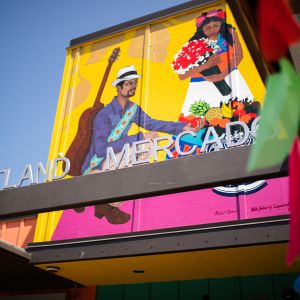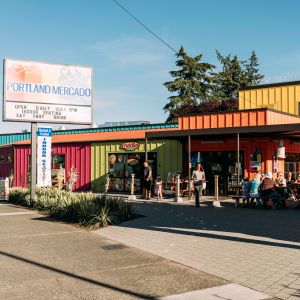

Latino Arts Shine at Milagro in Portland
Milagro in Portland’s Central Eastside has been home to Latiné-American arts and culture for over 30 years.
Marina Martinez-Bateman
Marina Martinez-Bateman (they/them) is an equity and communications consultant and ghost tour guide who moved to Portland in 2014. Read More
Smackdab in Portland’s Central Eastside, just a few blocks from a rooftop watering hole, several popular food cart pods and an interactive art museum, is the region’s only Latine theater production company, Milagro. This low-slung umber building hosts some of the most innovative projects in the Latin American diaspora and represents one of the longest-lasting pillars of the Portland Latino community. Its projects include an oral history documenting Latiné Oregonians, microgrants for local Latiné artists (like rising rapper Karma Rivera and visual storyteller Mika Martinez), and Portland’s longest-running Día de Muertos festival.
At 14% of the state’s population, Latin Americans are the largest ethnic group in Oregon, about 11% higher since Milagro was founded in 1985. “We showcase the diversity of Latin America; we elevate Black and Indigenous Latinos. People tend to think we’re all Mexicans, or we get called criminals and drug dealers. But here we tell the positive stories of the community,” says Artistic Director Dañel Malán.
Editor’s Note: We use Latinx and Latine in place of Latino or Latina to remain gender-inclusive.
Milagro Theatre FAQ
When is Milagro open?
When is the Milagro Dia De Los Muerto Festival?
How much are tickets to Milagro?
Where is Milagro Theatre?
Is Milagro Theatre accessible?
History of Teatro Milagro
Founded in 1985 by Executive Director José González and Dañel Malán, the theater originally produced Greek tragedies, beginning with their debut show, “Oedipus Rex.” They also founded the Ancient Greek Theatre Festival, hosted annually until the early 1990s.
People tend to think we’re all Mexicans, or we get called criminals and drug dealers. But here we tell the positive stories of the community.
Dañel Malán, Milagro Artistic Director
Out of nostalgia for his Southwest roots, González led the creation of Portland’s first Hispanic Cultural Festival, headlined by Illapu, the internationally celebrated Chilean folk-rock group who popularized the nueva canción Chilena music style. The inaugural festival in 1989 presented two plays, “Roosters” by Milcha Sanchez-Scott and “Burning Patience” by Antonio Skarmeta.
Milagro also used this festival to introduce its very first bilingual children’s production, “Perez y Martina,” by Thom Jenkins. “Children’s stories can be forgotten; it’s so important for the youth to see themselves on stage,” says one of Milagro’s actors, Enrique Andrade. “Maybe we plant the seed for them to say, ‘Hey, maybe I can be an actor, or maybe I can be a playwright someday.’”
In 1995, Milagro retired the Hispanic Cultural Festival and produced its first Día De Muertos Festival, which was then referred to by the more popular English-speaking malapropism Día De Los Muertos.
More Latine Culture
From shops to events to top-notch eateries, experience Portland's rich Latinx culture.
Experience El Centro Milagro
Located beside the Next Adventure outdoor store, Milagro is a short stroll or roll from the Portland Streetcar’s B Loop and TriMet bus line #6.
When you arrive at the theater, you’ll find the main entrance on Southeast Stark Street, while the entrance to El Zocalo, their large flex space, is around the corner under a mural by award-winning local artist José Solis. Together, the theater and El Zocalo form El Centro Milagro, a Latiné arts and culture community center that hosts such diverse guests as Eastern European improv troupes, political leaders and aspirants, many hordes of school children, internationally renowned scientists, activists and everyone in between.

Credit: Ben Martinez-Bateman
The theater has 121 seats around a three-quarter thrust stage, extending into the auditorium so the audience is seated around three sides. In a rare treat for a historic Portland building, the theater has air conditioning, making it a perfect escape on a hot summer day. It also has a functional hand-crank freight elevator still in use at over 100 years old.
Accessibility Fun Fact: The state-of-the-art curb cuts surrounding Milagro are so easy to navigate that Michelle’s Piano, located kitty-corner to the theater, regularly lends Milagro a grand piano by simply wheeling it across the two streets between them.
Events and Shows at Milagro
Milagro Theatre has two primary spaces for community and performance: the 121-seat theater itself and the flex space next to the theater. Seasons run from September to May and include plays in a mix of Spanish and English. Plays presented in Spanish get English subtitles on two screens mounted on either side of the stage. Usually, one bilingual children’s play and at least one art show are featured each season. There are also frequent screenings, panel discussions, workshops and other community events.

Credit: Ben Martinez-Bateman
Milagro is celebrating its 40th season in 2024, concluding with “Borderline.” An original play by Andrew Siañez-De La O, this teen tale inspired by borderland ghost stories is laden with real-world warnings. Milagro kicks off their 41st season during an election year in fall 2024 with “Celebrate the Changemakers,” which centers on themes of social injustice, changing gender norms and registering to vote.
Finally, to cap off the year, Milagro’s 29th Annual Día de Muertos Festival will explore gender identity through chosen family, followed by a bilingual portrait play about Frida Kahlo and Paul Olmos’ “A Home What Howls,” “a modern myth drawn from the real-life struggles of displaced communities around the globe.”
Was this page helpful?






